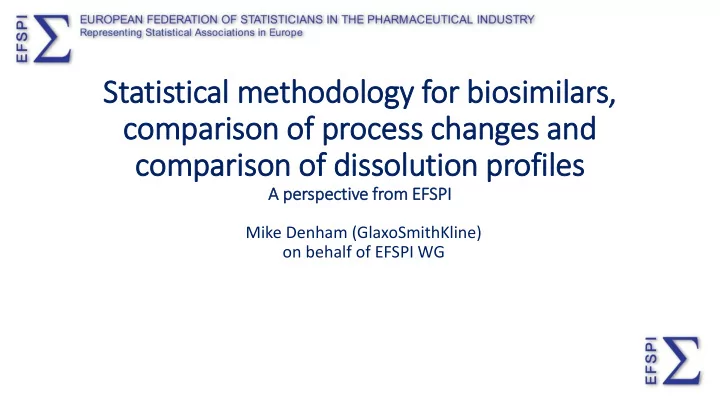

Statistical methodology for bio iosimil ilars, comparison of f process changes and comparison of f dis issolution profi files A persp specti tive fr from EFSPI Mike Denham (GlaxoSmithKline) on behalf of EFSPI WG
Three Fundamental Requirements • Define what we mean by equivalence/comparability • Provide a well-defined decision procedure • Demonstrate the operating characteristics of the procedure • What is the probability of deciding in favour of equivalence/comparability? • What is the patient risk? • (Test product is deemed equivalent/comparable and a patient receives a bad lot from the Test product) • What is the producer risk? • (Test product is deemed not to be equivalent/comparable when it is)
What do we mean by equivalent/comparable? • Demonstrate that proposed new process produces lots of Test product that are (analytically) “equivalent/comparable” to those of the Reference product (both now and in the future). When are the two distributions equivalent/comparable?
What do we mean by equivalent/comparable? • Demonstrate that proposed new process produces lots of Test product that are (analytically) “equivalent/comparable” to those of the Reference product (both now and in the future). When are the two distributions equivalent/comparable?
What do we mean by equivalent/comparable? • Demonstrate that proposed new process produces lots of Test product that are (analytically) “equivalent/comparable” to those of the Reference product (both now and in the future). When are the two distributions equivalent/comparable?
A Definition of Biosimilarity • The test product is analytically comparable (for a given attribute) to the Reference product if the middle P% of all lots produced by the Test product process lie within the middle P% of the lots produced by the Reference product process. • In what follows we will use 99%.
A Definition of Biosimilarity • Combinations of Mean and SD that would be considered Biosimilar Assumes Ref Mean = 100 Ref Var = 1
A Decision Procedure for Biosimilarity (1) • Interested in limits defined by central portion of distribution of Reference product lots • Mean and variance of Reference estimated with uncertainty • The b -content g -Confidence Tolerance Interval (TI) on Reference is recommended X k s Ref c Ref g b k : P P X k s X X k s X , s Ref Ref Ref c X c c X , s Ref Ref Ref Ref Ref • Takes into account the uncertainty on the Mean and the Variance • Better statistical properties than Min and Max • Both Content and Confidence can be controlled • A minimum sample size of Reference is recommended to make b -content g -Confidence Tolerance Interval (TI) relevant for Similarity limits. (Here we will use 15)
A Decision Procedure for Biosimilarity (2) • Test if b -Prediction Interval (PI) of biosimilar is within b - g -Tolerance Interval (TI) of reference X t s 1 1 / n b Test 1 / 2 , n 1 Test Test Test • Equivalent to a 100 β % Credible Interval based on Posterior Predictive Distribution of X given the observed data using a Jeffreys Prior • More relevant than using an arbitrary c factor (such as 3!) • Takes into account the variability of the Test process (between-lots) • Takes into account uncertainty on means and variability of new process • Demonstrates that Test lots will be within the range of Reference lots with some level of confidence even in the future
A Decision Procedure for Biosimilarity (3) • Test if b -Prediction Interval is within b - g -Tolerance Interval
Other Decision Procedures – FDA Tier Approach Tier 1 – Most Critical (1-2 α )100% two-sided Confidence Interval for Compares the means of the two distributions Difference in Means contained within +/-1.5 𝑡 𝑆𝑓𝑔 Compares the central Tier 2 – Moderate Critical portions of the two Quality Range Method: mean +/- k 𝑡 𝑆𝑓𝑔 distributions Tier 3 – Least Critical No ‘formal’ assessment of the two distributions Raw Data/Graphical Comparison
Demonstrate the Operating Characteristics (1) • Simulate or derive the performance of the decision rule for different combinations of the Mean and SD of the Test Product Process • E.g. • Assume Reference Mean = 100, Reference SD = 1 • # Reference Lots = 15 • # Test Lots = 5, 10, 15, 20, 25 Decision methods: • FDA Two-Sided 90% Confidence Interval of Mean Difference • FDA 90% of Test Lots in Mean +/- 3 SD • Proposal b PI within b / g TI (80% and 98% chosen here)
Demonstrate the Operating Characteristics (2)
Demonstrate the Operating Characteristics (3)
Patient Risk
Producer Risk
Backup Slides
80% PI within 80/98% TI Demonstrate the Operating Characteristics
80% PI within 80/98% TI Demonstrate the Operating Characteristics
80% PI within 80/98% TI Demonstrate the Operating Characteristics
80% PI within 80/98% TI Demonstrate the Operating Characteristics
80% PI within 80/98% TI Patient Risk
80% PI within 80/98% TI Producer Risk
99% PI within 99/95% TI Demonstrate the Operating Characteristics
99% PI within 99/95% TI Demonstrate the Operating Characteristics
99% PI within 99/95% TI Demonstrate the Operating Characteristics
99% PI within 99/95% TI Demonstrate the Operating Characteristics
99% PI within 99/95% TI Patient Risk
99% PI within 99/95% TI Producer Risk
Recommend
More recommend